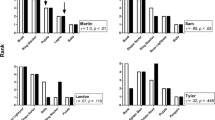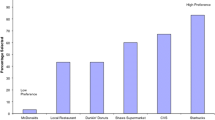Abstract
We compared the results of a brief electronic pictorial multiple-stimulus without replacement (EP-MSWO) preference assessment to a brief tangible MSWO preference assessment in five children with autism. Results of both assessments yielded a match between high preferred (HP) toys for four participants and low preferred toys for three participants. The overall correlation between assessments across participants was strong and statistically significant (ρ = .67, p < .01). A reinforcer assessment conducted with three participants confirmed HP toys identified in the EP-MSWO functioned as reinforcers.



Similar content being viewed by others
References
Brodhead, M. T., Al-Dubayan, M., Mates, M., Brouwers, L., & Abel, E. (2015). An evaluation of a brief video-based multiple-stimulus without replacement preference assessment. Behavior Analysis in Practice. doi:10.10007/s40617-015-0081-0.
Cannella, H. I., O’Reilly, M. F., & Lancioni, G. E. (2005). Choice and preference assessment research with people with severe to profound developmental disabilities: A review of the literature. Research in Developmental Disabilities, 26, 1–15. doi:10.1016/j.ridd/2004.01.006.
Carr, J. E., Nicolson, A. C., & Higbee, T. S. (2000). Evaluation of a brief multiple-stimulus preference assessment in a naturalistic context. Journal of Applied Behavior Analysis, 33, 353–357. doi:10.1891/jaba.2000.33-353.
Clevenger, T. M., & Graff, R. B. (2005). Assessing object-to-picture and picture-to-object matching as prerequisite skills for pictorial preference assessments. Journal of Applied Behavior Analysis, 38, 543–547. doi:10.1901/jaba.2005/161-04.
Daly, E. J., Wells, N. J., Swanger-Gagné, M. S., Carr, J. E., Kunz, G. M., & Taylor, A. M. (2009). Evaluation of the multiple-stimulus without replacement preference assessment method using activities as stimuli. Journal of Applied Behavior Analysis, 42, 563–574. doi:10.1901/jaba.2009.42-563.
DeLeon, I. G., & Iwata, B. A. (1996). Evaluation of a multiple-stimulus presentation format for assessing reinforcer preferences. Journal of Applied Behavior Analysis, 29, 519–533. doi:10.1901/jaba.1996.29-519.
Fisher, W., Piazza, C. C., Bowman, L. G., Hagopian, L. P., Owens, J. C., & Slevin, I. (1992). A comparison of two approaches for identifying reinforcers for persons with severe and profound disabilities. Journal of Applied Behavior Analysis, 25, 491–498. doi:10.1901/jaba.1992.25-491.
Groskreutz, M. P., & Graff, R. B. (2009). Evaluating pictorial preference assessment: The effect of differential outcomes on preference assessment results. Research in Autism Spectrum Disorders, 3, 113–128. doi:10.1016/j.rasd.2008.04.007.
Heinicke, M. (2014). Assessing the efficacy of pictorial preference assessments for children with developmental disabilities (Doctoral dissertation). https://etd.auburn.edu/handle/10415/4045
Higbee, T. S., Carr, J. E., & Harrison, C. D. (1999). The effects of pictorial versus tangible stimuli in stimulus-preference assessments. Research in Developmental Disabilities, 20, 63–72.
Kagohara, D., van der Meer, L., Ramdoss, S., O’Reilly, M., Lancioni, T., Davis, T., et al. (2013). Using iPods and iPads in teaching programs for individuals with developmental disabilities: A systematic review. Research in Developmental Disabilities, 34, 147–156. doi:10.1901/jaba.1996.29-519.
Kang, S., O’Reilly, M., Lancioni, G., Falcomata, T. S., Sigafoos, J., & Xu, Z. (2013). Comparison of the predictive validity and consistency among preference assessment procedures: A review of the literature. Research in Developmental Disabilities, 34, 1125–1133. doi:10.1016/j.ridd.2012.12.021.
Karsten, A. M., Carr, J. E., & Lepper, T. L. (2011). Description of a practicioner model for identifying preferred stimuli with individuals with autism spectrum disorder. Behavior Modification, 35, 347–369. doi:10.1177/0145445511405184.
Paramore, N. W., & Higbee, T. S. (2005). An evaluation of a brief multiple-stimulus preference assessment with adolescents with emotional-behavioral disorders in an educational setting. Journal of Applied Behavior Analysis, 38, 399–403. doi:10.1901/jaba.2005.76-04.
Pence, S. T., St. Peter, C. C., & Tetreault, A. S. (2012). Increasing accurate preference assessment implementation through pyramidal training. Journal of Applied Behavior Analysis, 45, 345–359. doi:10.1901/jaba.2012.45-345.
Piazza, C. C., Fisher, W. W., Hagopian, L. P., Bowman, L. G., & Toole, L. (1996). Using a choice assessment to predict reinforcer effectiveness. Journal of Applied Behavior Analysis, 29, 1–9. doi:10.1901/jaba.1996.29-1.
Rosales, R., Gongola, L., & Homlitas, C. (2015). An evaluation of video modeling with embedded instructions to teach implementation of stimulus preference assessments. Journal of Applied Behavior Analysis, 48, 209–214. doi:10.1002/jaba.174.
Roscoe, E. M., Iwata, B. A., & Kahng, S. (1999). Relative versus absolute reinforcement effects: Implications for preference assessments. Journal of Applied Behavior Analysis, 32, 479–493. doi:10.190/jaba.1999.32-479.
Snyder, K., Higbee, T. S., & Dayton, E. (2012). Preliminary investigation of a video-based stimulus preference assessment. Journal of Applied Behavior Analysis, 45, 413–418.
Sundberg, M. L. (2008). The verbal behavior milestones assessment and placement program: The VB-MAPP guide. Concord, CA: AVB Press.
Taravella, C. C., Lerman, D. C., Contrucci, S. A., & Roane, H. S. (2000). Further evaluation of low-ranked items in stimulus-choice preference assessments. Journal of Applied Behavior Analysis, 33, 105–108. doi:10.1901/jaba.2000.33-105.
Tullis, C. A., Canella-Malone, H. I., Basbigill, A. R., Yeager, A., Flemming, C. V., Paybe, D., & Wu, P. F. (2011). Review of the choice and preference assessment literature for individuals with severe to profound disabilities. Education and Training in Autism and Developmental Disabilities, 46, 576–595.
Whitehouse, C. M., Vollmer, T. R., & Colbert, B. (2014). Evaluating the use of computerized stimulus preference assessments in foster care. Journal of Applied Behavior Analysis, 47, 470–484. doi:10.1002/jaba.148.
Author information
Authors and Affiliations
Corresponding author
Ethics declarations
Conflict of interest
Matthew T. Brodhead declares he has no conflict of interest. Emily, A. Abel declares she has no conflict of interest. Monerah N. Al-Dubayan declares she has no conflict of interest. Lauren Brouwers declares she has no conflict of interest. Gina Warren Abston declares she has no conflict of interest. Mandy J. Rispoli declares she has no conflict of interest.
Ethical Approval
All procedures performed in studies involving human participants were in accordance with the ethical standards of the institutional and/or national research committee and with the 1964 Helsinki declaration and its later amendments or comparable ethical standards.
Informed Consent
Informed consent was obtained from all individual participants included in the study.
Rights and permissions
About this article
Cite this article
Brodhead, M.T., Abel, E.A., Al-Dubayan, M.N. et al. An Evaluation of a Brief Multiple-Stimulus Without Replacement Preference Assessment Conducted in an Electronic Pictorial Format. J Behav Educ 25, 417–430 (2016). https://doi.org/10.1007/s10864-016-9254-3
Published:
Issue Date:
DOI: https://doi.org/10.1007/s10864-016-9254-3




